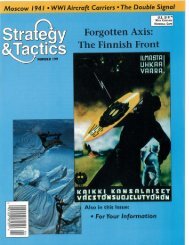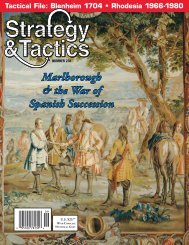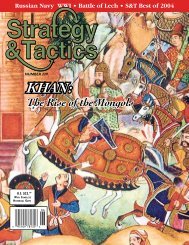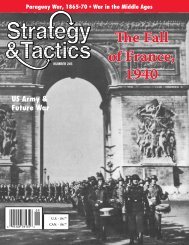COUNTERSTROKE AT SOLTSY - Strategy & Tactics Press
COUNTERSTROKE AT SOLTSY - Strategy & Tactics Press
COUNTERSTROKE AT SOLTSY - Strategy & Tactics Press
Create successful ePaper yourself
Turn your PDF publications into a flip-book with our unique Google optimized e-Paper software.
(the French campaign in Egypt and Syria, 1798-1800); On to<br />
Constantinople (Russia versus Turkey, 1806-07, a campaign<br />
that saw, among other things, the citizenry of Constantinople<br />
repulse a British fleet); Winter War (Russia invades Finland<br />
and fights Sweden, 1808-09). Each side will have a morale<br />
index that will give bonuses in combat and movement if you<br />
are winning, and can lead to collapse if it goes too low—but<br />
can also be used to obtain an armistice on favorable terms<br />
even if you are losing. Joseph Miranda.<br />
B5. Sun Never Sets II. This will be a sequel game to DG’s<br />
Sun Never Sets, covering the wars of the British Empire in<br />
the 19 th century. Units are battalions for “civilized” armies<br />
and warbands for others. Each unit is rated for its weapons,<br />
type, strength, morale and movement. A unique quasitactical<br />
combat resolution system catches the spirit of the<br />
era with everything from Gatling guns to bayonet charges.<br />
There’s always the chance to break a British square, or rout a<br />
superior enemy force. All major leaders are included, as well<br />
as random events, supply, engineers and railroad building.<br />
Game scale is operational, with the entire theater of operations<br />
covered. Scenarios will be drawn from: Egypt 1882,<br />
Second Afghan War, Asante War and Persia.Designer: Roger<br />
Deal<br />
B6. Thirty Years War Battles. More battles using the Thirty<br />
Years War Quad system. Two battles would be drawn from:<br />
Fleurus, Alte Veste, Wittstock, and Lens (others from the era<br />
may be substituted). Joseph Miranda.<br />
americana (circa 1700 to 1900 a.D.; mark 1<br />
to 5)<br />
C1. War in the Far West. A simulation of the American<br />
Civil War in the southwest USA, Texas to California, 1861-<br />
62. The historic campaign saw small Confederate and Union<br />
armies maneuvering over vast territories in actions that contested<br />
control of the American frontier and could have decided<br />
the course of the entire war. The order of battle will<br />
include regular infantry, cavalry, engineers, artillery, militia,<br />
rangers and Indian scouts. All major leaders will be represented.<br />
Also included will be supply depots (which can be<br />
captured), forts, buffalo hunts, brevet ranks and the infamous<br />
“mule mines.” Chuck Diamond.<br />
C2. American Revolution. The game will have several scenarios,<br />
representing different times in the war, as well as a<br />
campaign scenario. Option cards will play off raising troops<br />
against maintaining the loyalty of different colonies as well<br />
as gaining or preventing French intervention. They will also<br />
generate temporary objectives, such as the invasion of Canada.<br />
Units will be different types of brigades (regulars, militia,<br />
dragoons, light infantry) that can be built into “wings”<br />
(divisions). Joseph Miranda.<br />
C3. La Glorieta Pass. At the high tide of the Confederate<br />
advance in the far west in March 1862, Gen. Sibley had captured<br />
Sante Fe and was threatening to advance into Colorado.<br />
Union forces were hastily gathered at Fort Union to<br />
counter his advance. The advance guards of the two forces<br />
clashed in Apache Canyon on 26 March, and the two main<br />
forces fought near La Glorieta Pass two days later. The Confederates<br />
were unable to break the Union forces, and lost<br />
most of their supplies to a Union raid, thereby forcing their<br />
retreat to Texas. The game would focus on the two battles<br />
using the original Twilight’s Last Gleaming system. Chuck<br />
Diamond.<br />
C4. Battles of The Valley. Jackson’s campaign in the<br />
Shenandoah Valley was one of the great sideshows of the<br />
Civil War. He never commanded more than 18,000 troops,<br />
yet managed to tie down over 60,000 Union troops, winning<br />
several battles and inflicting disproportionate losses. The<br />
game would use a system similar to Twilight’s Last Gleaming<br />
and feature two or three battles drawn from Kernstown,<br />
McDowell, Front Royal, Winchester, Cross Keys, and Port<br />
Royal. Chuck Diamond.<br />
C5. Pea Ridge. In February 1862, Confederate Gen. Earl<br />
Van Dorn launched his forces against the Union Army of<br />
the Southwest. After a night march in a snowstorm, the exhausted<br />
rebels nearly brought off a double envelopment of<br />
the enemy. Except for the untimely death of three key officers,<br />
Van Dorn might have cleared Missouri of Federals and<br />
precluded Grant’s Donelson campaign. Pea Ridge will use<br />
the Fateful Lightning system to recreate this critical battle.<br />
Units are regiments and battalions. Leaders enhance combat<br />
and movement, but only the key leaders are represented<br />
in the game. Hexes are 250m across; turns are 30 minutes.<br />
Both sides will have variable orders of battle, organization,<br />
deployment and missions to add to the fog of war. Chris Perello.<br />
early 20th century (circa 1898 to 1929 a.D.;<br />
mark 1 to 6)<br />
D1. First Battle of Britain. In World War I German zeppelins<br />
and Gotha bombers intruded into the skies over Britain<br />
in the first strategic air campaign. First Battle of Britain<br />
would be a fast moving simulation of this campaign. Units<br />
would represent individual zeppelins, aircraft squadrons, antiaircraft<br />
emplacements and various types of targets. Victory<br />
conditions would be a combination of military, economic<br />
and psychological objectives. The British would have the<br />
opportunity to strike back by launching raids against German<br />
airdromes, and developing early aircraft carriers. Players<br />
would have the opportunity to develop new technologies,<br />
such as radio coordination and early warning systems. Pilot<br />
quality would be a critical factor, and there would also be<br />
several historical individuals represented. 22 x 34” map, 280<br />
counters. To be designed by Joseph Miranda.<br />
D2. The Kaiser’s War. At the end of 1917, the Kaiser’s<br />
armies had triumphed in the Balkans, Italy and Russia,<br />
and the Second Reich stretched from central France to the<br />
Ukraine. A year later, that imperial edifice had come crashing<br />
down in ruin. The Kaiser’s War would be a strategiclevel<br />
wargame of the year 1918. The game map would cover<br />
France, the Low Countries, northern Italy, central Europe,<br />
the Balkans, Russia to the Volga, and the Ottoman Empire.<br />
Units would be mostly armies along with “army detachment”<br />
breakdowns. There would be special units such as<br />
shock troops (of all nations, not just Germany), tanks, the<br />
Asian Korps, Bolshevik Red Guards, etc. There would be<br />
a simple air war system, and naval units would be shown at<br />
fleet level, with the possibility of a sortie by the Austro-Hungarian<br />
Fleet if the Italians are defeated. Joseph Miranda.<br />
D3. First Blood Marne—Battles on the Marne, June-August<br />
1918. Though previously involved in battle, American<br />
troops were only blooded well and true for the first time in<br />
the First World War at the important Battle of Chateau-Thierry<br />
in June 1918. The green Yankees were committed at the<br />
very nose of the still potent German penetration along the<br />
Marne and not only stopped the enemy drive, but managed to<br />
strategy & tactics 59







